Undeterred by civil actions, extremist monk at Kokku'laay vows to complete controversial Vihara
[TamilNet, Thursday, 28 April 2016, 05:27 GMT]
The occupying Sinhala military is deployed round-the-clock to construct the controversial Buddhist temple-centric establishment, conceived as a tool for Sinhalicisation of the strategic coastal stretch at Kokku'laay, which links Northern and Eastern provinces of the country of Eezham Tamils. The construction is proceeding despite repeated requests to find an alternative place from Northern Provincial Council Chief Minister Justice C.V. Wigneswaran and despite instructions from Mullaiththeevu District Secretariat to halt the construction till the dispute of private land, which has been occupied by the Sinhala extremist monk, is resolved. On Sunday, Ven Sri Thissapura Gunarathna Thero, the extremist monk was demonstrating his vow to continue with the construction when he spotted Tamil journalists taking video of the resumed construction work from a distance.
The construction is taking place with the active participation by Sinhala military men under the direct supervision of the extremist monk, the journalists who witnessed the construction told TamilNet.
It is the occupying Sinhala military, which exercises ultimate control of all affairs in the country of Eezham Tamils, is the message given by Colombo.
A newly created division, Sinhalicised in demograhpy and acquired a name ‘Weli Oya’ changed from the Tamil name Ma'nal-aa'ru, was formalised with a divisional secretariat of the civil administrative structure of occupying Sri Lanka in the Mullaith-theevu district in 2011. The SL military governor under former SL President Mahinda Rajapaksa was playing a crucial role in implementing the demographic change at that time.
Informed sources in Jaffna told TamilNet that the current colonial governor from Colombo, Reginald Cooray, recently appointed by SL President Maithiripala Sirisena has also been exerting pressure on Eezham Tamil landowners at Kokku'laay to sell out their lands to Buddhist monk.
The occupying Sinhala military is deployed round-the-clock to construct the controversial Buddhist temple-centric establishment, conceived as a tool for Sinhalicisation of the strategic coastal stretch at Kokku'laay, which links Northern and Eastern provinces of the country of Eezham Tamils. The construction is proceeding despite repeated requests to find an alternative place from Northern Provincial Council Chief Minister Justice C.V. Wigneswaran and despite instructions from Mullaiththeevu District Secretariat to halt the construction till the dispute of private land, which has been occupied by the Sinhala extremist monk, is resolved. On Sunday, Ven Sri Thissapura Gunarathna Thero, the extremist monk was demonstrating his vow to continue with the construction when he spotted Tamil journalists taking video of the resumed construction work from a distance.
The construction is taking place with the active participation by Sinhala military men under the direct supervision of the extremist monk, the journalists who witnessed the construction told TamilNet.
It is the occupying Sinhala military, which exercises ultimate control of all affairs in the country of Eezham Tamils, is the message given by Colombo.
A newly created division, Sinhalicised in demograhpy and acquired a name ‘Weli Oya’ changed from the Tamil name Ma'nal-aa'ru, was formalised with a divisional secretariat of the civil administrative structure of occupying Sri Lanka in the Mullaith-theevu district in 2011. The SL military governor under former SL President Mahinda Rajapaksa was playing a crucial role in implementing the demographic change at that time.
Informed sources in Jaffna told TamilNet that the current colonial governor from Colombo, Reginald Cooray, recently appointed by SL President Maithiripala Sirisena has also been exerting pressure on Eezham Tamil landowners at Kokku'laay to sell out their lands to Buddhist monk.
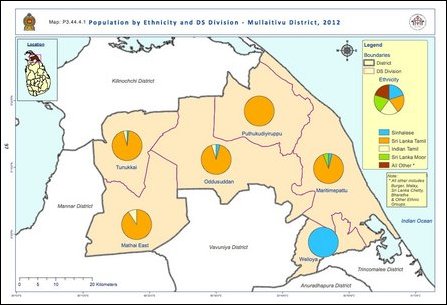
The
Census Map of 2012 showing Weli-oya, a recently created and colonized
division of the Mullaith-theevu district as an exclusive Sinhala
division. The division has now wedged the contiguity between the Tamil
districts Vavuniyaa in the Northern Province and Trincomalee in the
Eastern Province, while it established contiguity with the Sinhala
district Anuradhapura in the North Central Province.
The ‘Catholic’ governor has also shown extreme interest in promoting construction of Buddha statue at Nayinaatheevu, an islet situated off Jaffna.
The monk at Kokku'laay has been
given green signal to proceed with the construction work by Mr Cooray,
the sources further said.
Eezham Tamils were initially chased away from Kokku'laay on 22 December
1984. The was only one temple at the place for several years. It was a
temple of Ka'n'naki amman, the heroine-turned-goddess from the popular
Tamil epic of Chilappathikaaram.
“The very old Ka'n'naki Amman temple was fully intact when we were forced to leave,” says 51-year-old Tharmaratnam Kumarasepillai, who is now the secretary of the temple trusteeship.
Ka'na'naki temple had been completely destroyed when the people returned to resettle at their native village after the 2009 genocidal onslaught and it is being now reconstructed with the help from resettled Eezham Tamils.
64-year-old Jeyasingam Kayilayapillai, who is the president of the trusteeship says there was never a Buddhist vihara in the locality.
“The very old Ka'n'naki Amman temple was fully intact when we were forced to leave,” says 51-year-old Tharmaratnam Kumarasepillai, who is now the secretary of the temple trusteeship.
Ka'na'naki temple had been completely destroyed when the people returned to resettle at their native village after the 2009 genocidal onslaught and it is being now reconstructed with the help from resettled Eezham Tamils.
64-year-old Jeyasingam Kayilayapillai, who is the president of the trusteeship says there was never a Buddhist vihara in the locality.
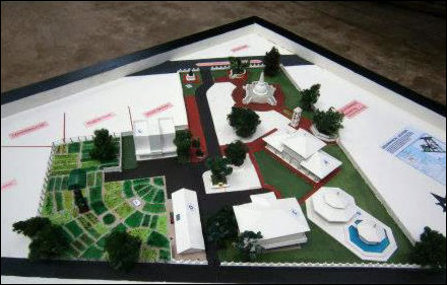
Temple to the East and ‘other activities’ to the West
The monk, backed by SL military and
the Colombo Establishment, has started to construct it. The monk is
fully backed by the UNP and SLFP rulers as well as extremist Bodu Bala
Sena (Buddhist Power Force), is defying all instructions from the
Courts, the elected provincial government and the district-level Tamil
officials.
Four years ago, the Sinhala soldiers had put up a temporary hut for Thissapura Gunarathana Thero with the donations from Sampath Bank.
A private surveyor, Wilmot Silva, brought down from Maharagama in Colombo by the Thero with the ‘approval’ of the then Divisional Secretary C Dayananda, to surveyed more than three acres of the seized lands in 2012.
In the meantime, a tube well was dug at the premises and the locality became popular for fresh water.
The monk transformed the site of the tube well into a ‘Pinthalaya’, a term used for a holy site where Buddhist pilgrims were given potable water at no cost.
The Pinthalaya was also transformed into a memorial site of two fallen Sinhala military soldiers. The Tamil villagers were told to honour the Sinhala ‘war heroes’ each time they went to the Pinthalaya to tap potable water from the locality.
Three Bo-trees, one Tamarind tree, 11 Neem (Veampu), one Banyan and two Palmyra trees are located in the lands seized by the Thero.
In addition to the buildings of Chamber (a tri-part structure with Buddha statue in the central chamber), bell tower, Stupa (shell dome) which will be 10 meter high to its crest and rested upon a 2-meter high round structure, Dhammasala (preaching hall) with eight peripheral columns, Pohoya Geya (Chapter house) with a lotus pond and a two-storied monastery (Sangharamaya), the temple establishment is to incorporate an area housing ‘other activities’ to the West of the Vihara buildings, separated by a north-South running internal road. This area is called ‘welfare area’, where the monk is planning to construct a multi-purpose building, a vocational training centre and a model farm.
100 perches of land plot have been seized for the model farm, which aims to introduce agriculture to fisheries-dependent settlers, who are set to grab more agricultural lands from Eezham Tamils in Kokku'laay.
The extremist monk, who seeks to convert the Sinhala Catholics into Buddhism and to raise the young generation of the Sinhala occupiers with the agenda of Sinhalicisation of the strategic Kokku'laay link, has perceived a five floor Multi-Purpose building for that purpose. This building will be consisting of a nursery, refectory, library and other facilities. Only three floors are to be constructed in the beginning according to the model.
The vocational training centre is to cater the adult women and men. It will be housing a sewing centre for the settling women, a dairy product unit (yoghurt production), Diveneguma-assisted carpenter and welding workshop and a fertilizer manufacturing plant.
The model farm also aims to ‘integrate’ both the children of Sinhala and Tamil schools into the future programme of Sinhalicisation with the assistance of ‘Sri Lankan’ Agrarian Department.
Four years ago, the Sinhala soldiers had put up a temporary hut for Thissapura Gunarathana Thero with the donations from Sampath Bank.
A private surveyor, Wilmot Silva, brought down from Maharagama in Colombo by the Thero with the ‘approval’ of the then Divisional Secretary C Dayananda, to surveyed more than three acres of the seized lands in 2012.
In the meantime, a tube well was dug at the premises and the locality became popular for fresh water.
The monk transformed the site of the tube well into a ‘Pinthalaya’, a term used for a holy site where Buddhist pilgrims were given potable water at no cost.
The Pinthalaya was also transformed into a memorial site of two fallen Sinhala military soldiers. The Tamil villagers were told to honour the Sinhala ‘war heroes’ each time they went to the Pinthalaya to tap potable water from the locality.
Three Bo-trees, one Tamarind tree, 11 Neem (Veampu), one Banyan and two Palmyra trees are located in the lands seized by the Thero.
In addition to the buildings of Chamber (a tri-part structure with Buddha statue in the central chamber), bell tower, Stupa (shell dome) which will be 10 meter high to its crest and rested upon a 2-meter high round structure, Dhammasala (preaching hall) with eight peripheral columns, Pohoya Geya (Chapter house) with a lotus pond and a two-storied monastery (Sangharamaya), the temple establishment is to incorporate an area housing ‘other activities’ to the West of the Vihara buildings, separated by a north-South running internal road. This area is called ‘welfare area’, where the monk is planning to construct a multi-purpose building, a vocational training centre and a model farm.
100 perches of land plot have been seized for the model farm, which aims to introduce agriculture to fisheries-dependent settlers, who are set to grab more agricultural lands from Eezham Tamils in Kokku'laay.
The extremist monk, who seeks to convert the Sinhala Catholics into Buddhism and to raise the young generation of the Sinhala occupiers with the agenda of Sinhalicisation of the strategic Kokku'laay link, has perceived a five floor Multi-Purpose building for that purpose. This building will be consisting of a nursery, refectory, library and other facilities. Only three floors are to be constructed in the beginning according to the model.
The vocational training centre is to cater the adult women and men. It will be housing a sewing centre for the settling women, a dairy product unit (yoghurt production), Diveneguma-assisted carpenter and welding workshop and a fertilizer manufacturing plant.
The model farm also aims to ‘integrate’ both the children of Sinhala and Tamil schools into the future programme of Sinhalicisation with the assistance of ‘Sri Lankan’ Agrarian Department.
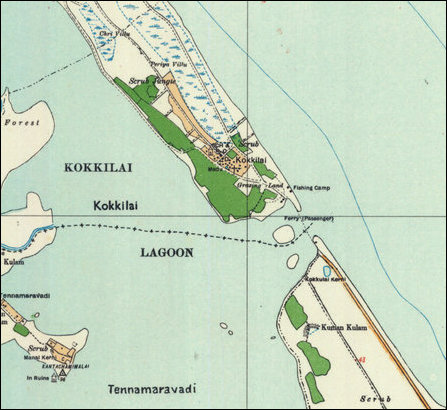
A
One Inch Sheet of the Survey Department, originally prepared in the
British times and last revised in 1978, shows the traditional Tamil
village having a Hindu temple and a church.
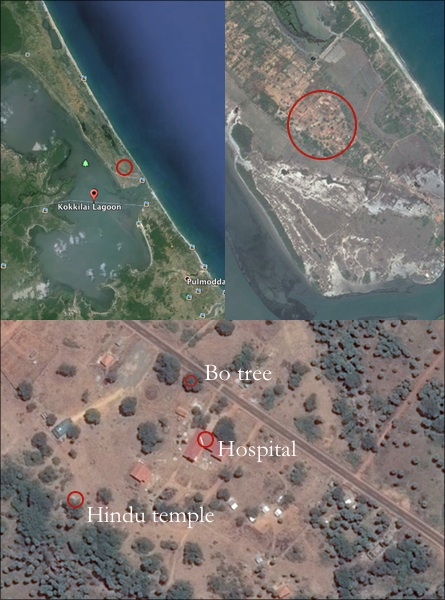
The location of Buddhist temple establishment [Image courtesy: Google Earth]
Chronology:

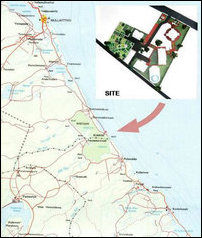

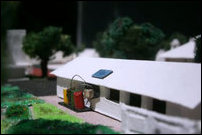
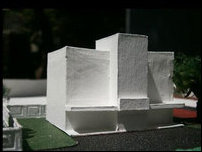
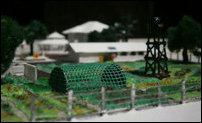
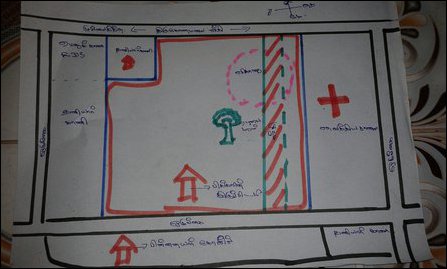
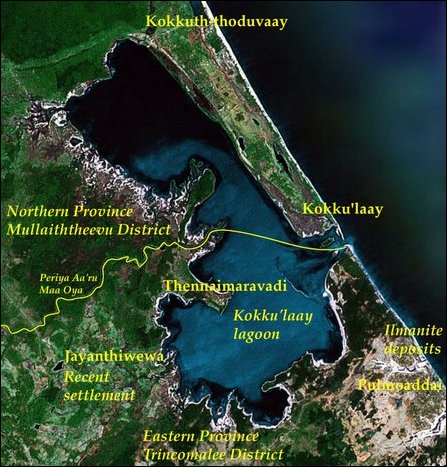
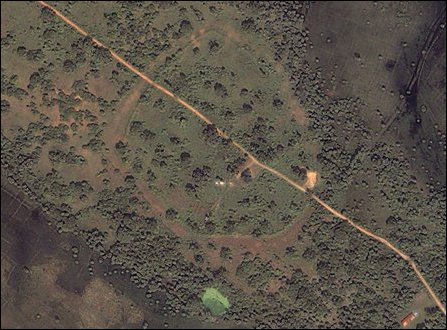
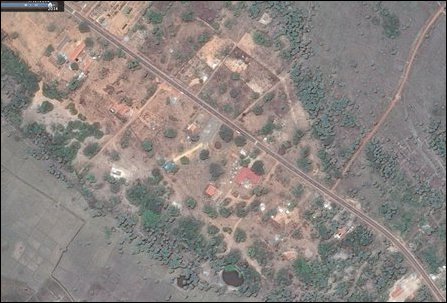
கருத்துகள் இல்லை:
கருத்துரையிடுக